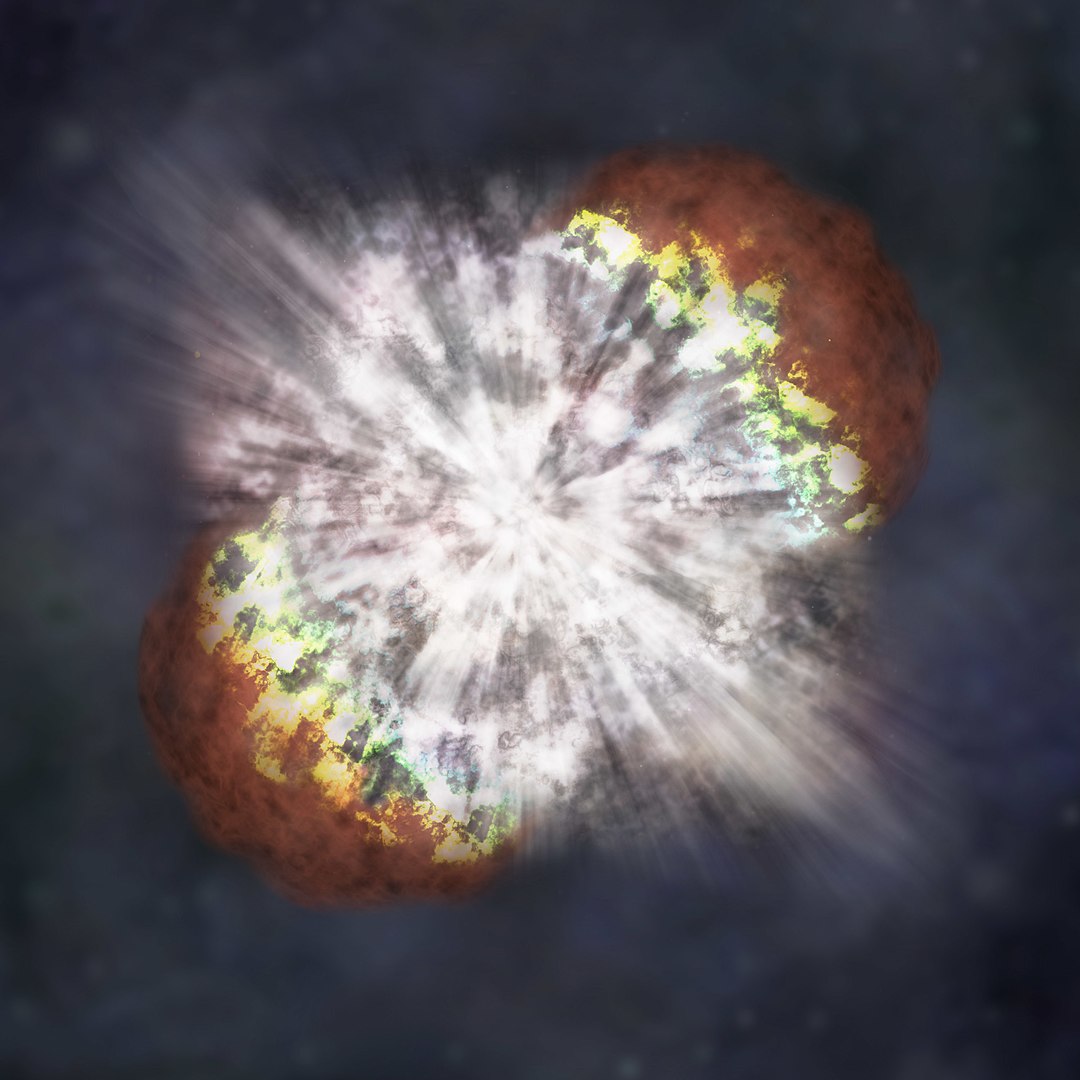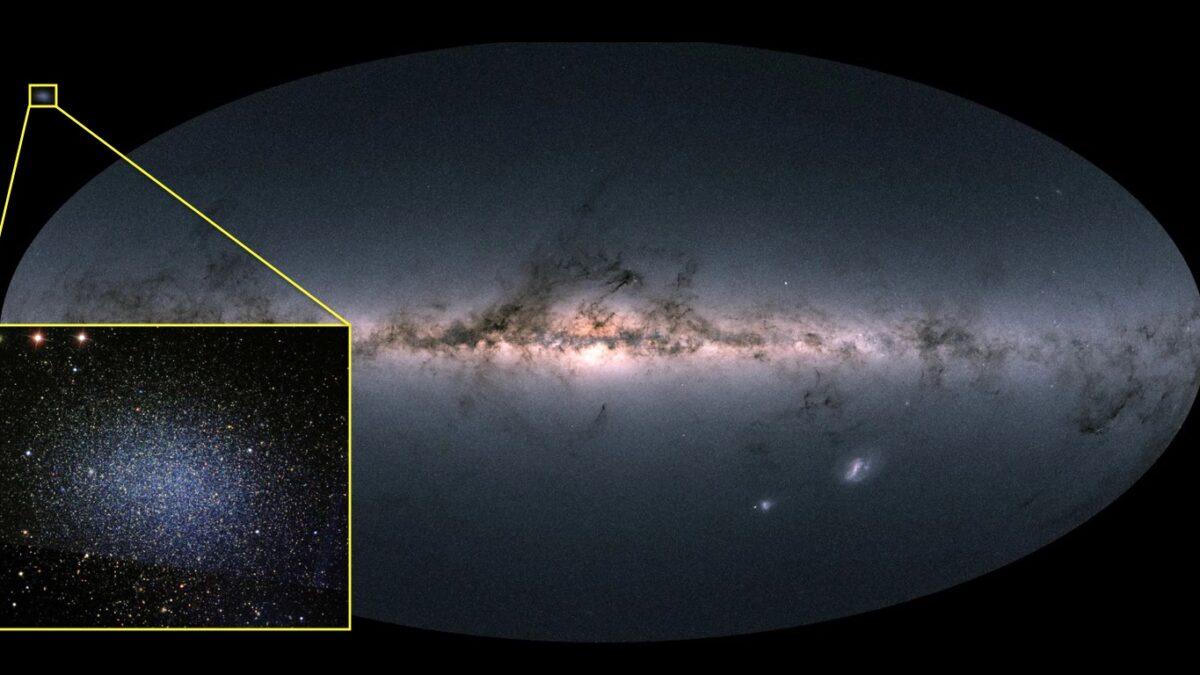Looking to do some mining in space? Need a little Ytterbium on your next flight through the galaxy? Researchers have figured out the best places in the cosmos to find this unusual but useful element.
Continue reading “Need Some More Ytterbium? Who Doesn’t? Here’s Where you can Find it in Space”A Nearby Dwarf Galaxy has a Surprisingly Massive Black Hole in its Heart
Since the 1970s, scientists have known that within the cores of most massive galaxies in the Universe, there beats the heart of a Supermassive Black Hole (SMBH). The presence of these giant black holes causes these galaxies to be particularly energetic, to the point where their central regions outshine all the stars in their disks combined – aka. Active Galactic Nuclei (AGN). The Milky Way galaxy has its own SMBH, known as Sagittarius A*, which has a mass of over 4 million Suns.
For decades, scientists have studied these objects in the hopes of learning more about their role in galactic formation and evolution. However, current research has shown that SMBHs may not be restricted to massive galaxies. In fact, a team of astronomers from the University of Texas at Austin’s McDonald Observatory recently discovered a massive black hole at the heart of a dwarf galaxy that orbits the Milky Way (Leo I). This finding could redefine our understanding of how black holes and galaxies evolve together.
Continue reading “A Nearby Dwarf Galaxy has a Surprisingly Massive Black Hole in its Heart”Supermassive Black Holes can Turn Star Formation On and Off in a Large Galaxy
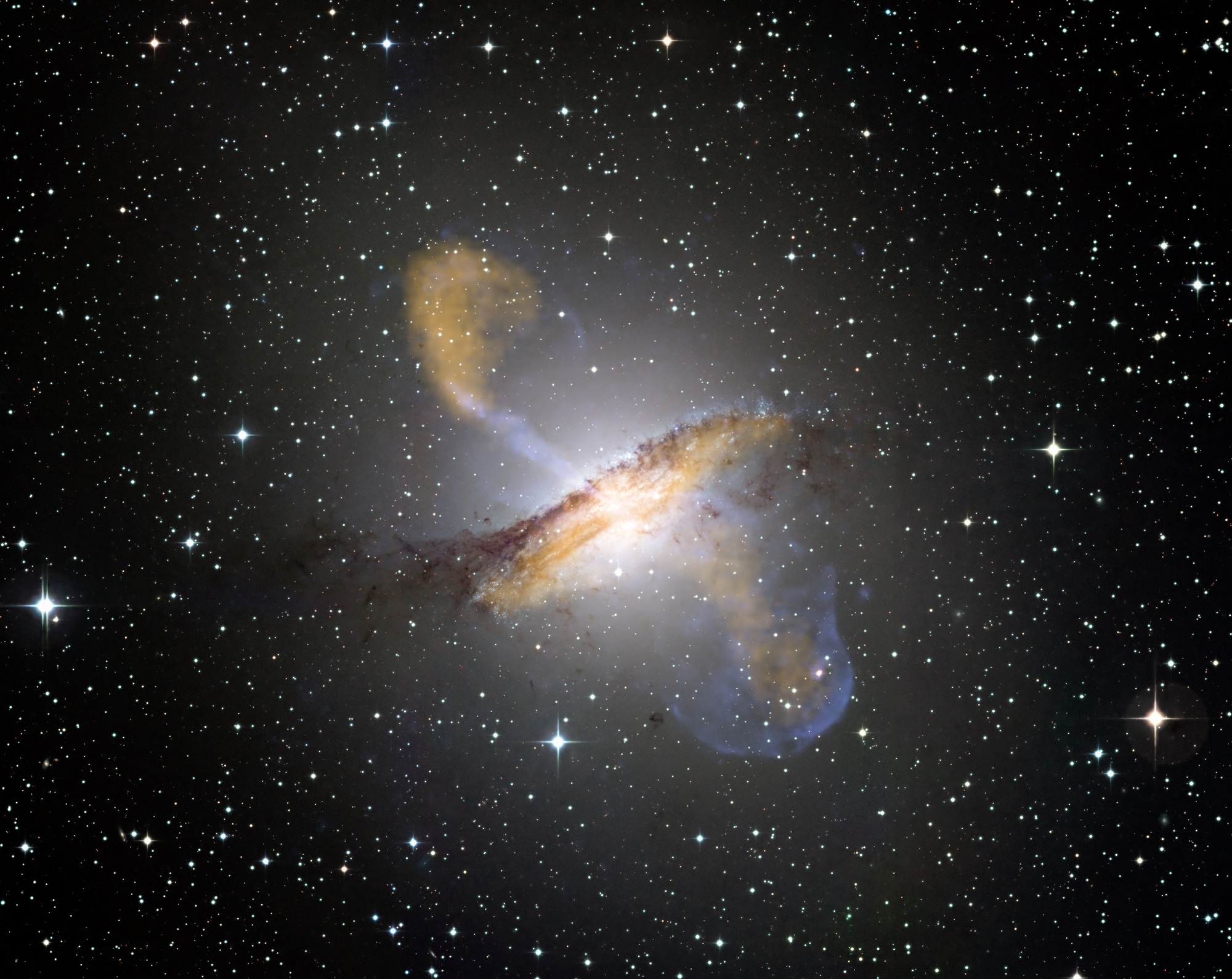
In the 1970s, astronomers discovered that a particularly large black hole (Sagittarius A*) existed at the center of our galaxy. In time, they came to understand that similar Supermassive Black Holes (SMBHs) existed in the center of most massive galaxies. The presence of these black holes was also what differentiated galaxies that had particularly luminous cores – aka. Active Galactic Nuclei (AGN) – from those that didn’t.
Since that time, astronomers and cosmologists have pondered what role SMBHs have on galactic evolution, with some venturing that they have a profound impact on star formation. And thanks to a recent study by an international team of astronomers, there is now direct evidence for a correlation between and SMBH and a galaxy’s star formation. In fact, the team demonstrated that a black hole’s mass could determine when star formation in a galaxy will end.
The study, titled “Black-Hole-Regulated Star Formation in Massive Galaxies“, recently appeared in the scientific journal Nature. Led by Ignacio Martín-Navarro, a Marie Curie Fellow at the University of California Observatories, the study team also consisted of members from the Max-Planck Institute for Astronomy and the Instituto de Astrofísica de Canarias.
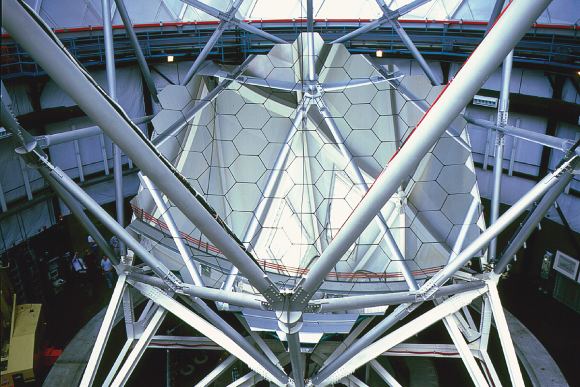
For the sake of their study, the team relied on data gathered the Hobby-Eberle Telescope Massive Galaxy Survey in 2015. This systematic survey used the 10m Hobby-Eberly Telescope (HET) at the McDonald Observatory to conduct an optical long-slit spectroscopic survey of over 1000 galaxies. This survey not only provided spectra for these galaxies, but also produced direct mass measurements of the central black holes for 74 of these galaxies.
Using this data, Martín-Navarro and his colleagues found the first observational evidence for a direct correlation between the mass of a galaxy’s central black hole and its history of star formation. While astrophysicists have been operating under this assumption for decades, the proof was missing until now. As Jean Brodie, professor of astronomy and astrophysics at UC Santa Cruz and a coauthor of the paper, said in a UCSC press release:
“We’ve been dialing in the feedback to make the simulations work out, without really knowing how it happens. This is the first direct observational evidence where we can see the effect of the black hole on the star formation history of the galaxy.”
Roughly 15 years ago, the correlation between a SMBHs mass and the total mass of a galaxy’s stars was discovered, which led to a major unresolved question in astrophysical circles. While this correlation appeared to be a central feature of galaxies, it was unclear as to what could have caused it. How could the mass of a comparatively small and central black hole be related to the mass of billions of stars distributed throughout a galaxy?
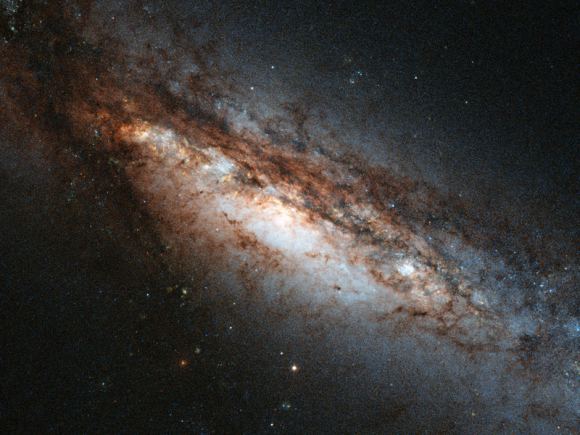
One possible explanation was that more massive galaxies collected larger amounts of gas, thus resulting in more stars and a more massive central black hole. However, astrophysicists also believed their was a feedback mechanism at work, where growing black holes inhibited the formation of stars in their vicinity. In short, when matter accretes on a central black hole, it sends out a tremendous amount of energy in the form of radiation and particle jets.
If this energy is transferred to gas and dust surrounding the core of the galaxy, stars will be less likely to form in this region since gas and dust need to be cold in order to undergo areas of collapse. For years, feedback of this kind has been included in cosmological simulations to explain the observed star-formation rates in galaxies. According to these same simulations, minus this mechanism, galaxies would form far more stars than have been observed.
However, no direct evidence of this phenomena had previously been available. The first step to obtaining some was to reproduce the stellar formation histories of the 74 target galaxies used for the study. Martín-Navarro and his colleagues did this by subjecting spectra obtained from each of these galaxies to computational techniques that looked for the best combination of stellar populations to fit the data.
In so doing, the team was able to reconstruct the history of star formation within the target galaxies for the past 12.5 billion years. After examining these histories, they noticed some predictable results, but also some rather significant differences. For starters, as predicted, the regions of around the galaxies’ central black holes demonstrated a clear dampening influence on the rate of star formation.
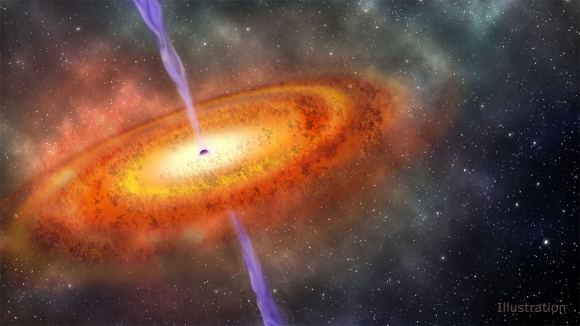
As predicted, there was also a clear correlation between the mass of the central black holes and stellar mass in these galaxies. However, the team also noted that in cases where stellar mass was slightly smaller than expected (relative to the mass of their central black holes), star formation rates were lower. In some other cases, galaxies had larger-than-expected stellar masses (again, relative to their black holes) and their star formation rates were higher.
This correlation was not only more consistent than that observed between black hole mass and stellar mass, it occurred independently of other factors (such as shape or density). As Martín-Navaro explained:
“For galaxies with the same mass of stars but different black hole mass in the center, those galaxies with bigger black holes were quenched earlier and faster than those with smaller black holes. So star formation lasted longer in those galaxies with smaller central black holes.”
They also noted that this correlation extends into the deep past, where the galaxies with supermassive central black holes have been consistently producing a comparatively low rate of stars for the past 12.5 billion years. This constitutes the first strong evidence for a direct, long-term connection between star formation and the existence of a central black hole in a galaxy.
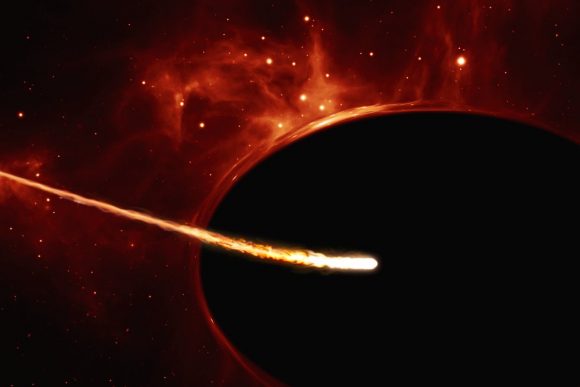
Another interesting takeaway from the study was the way it addressed possible correlations between AGN luminosity and star formation. In the past, other researchers have sought to find evidence of a link between the two, but without success. According to Martín-Navarro and his team, this may be because the time scales are incredibly different. Whereas star formation occurs over the course of eons, outbursts from AGNs occur over shorter intervals.
What’s more, AGNs are highly variable and their properties are dependent on a number of factors relating to their black holes – i.e. size, mass, rate of accretion, etc. “We used black hole mass as a proxy for the energy put into the galaxy by the AGN, because accretion onto more massive black holes leads to more energetic feedback from active galactic nuclei, which would quench star formation faster,” said Martin-Navarro.
Looking ahead, the team hopes to conduct further research and determine exactly how central black holes arrest star formation. At present, the possibility that it could be due to radiation or jets of gas heating up surrounding matter are not definitive. As Aaron Romanowsky, an astronomer at San Jose State University and UC Observatories, indicated:
“There are different ways a black hole can put energy out into the galaxy, and theorists have all kinds of ideas about how quenching happens, but there’s more work to be done to fit these new observations into the models.”
Part of determining how the Universe came to be is knowing what mechanisms were at play and the extent of their roles. With this latest study, astrophysicists and cosmologists can take comfort in the knowledge that they’ve been getting it right – at least in this case!
Uranus’ “Frankenstein Moon” Miranda

Ever since the Voyager space probes ventured into the outer Solar System, scientists and astronomers have come to understand a great deal of this region of space. In addition to the four massive gas giants that call the outer Solar System home, a great deal has been learned about the many moons that circle them. And thanks to photographs and data obtained, human beings as a whole have come to understand just how strange and awe-inspiring our Solar System really is.
This is especially true of Miranda, the smallest and innermost of Uranus’ large moons – and some would say, the oddest-looking! Like the other major Uranian moons, its orbits close to its planet’s equator, is perpendicular to the Solar System’s ecliptic, and therefore has an extreme seasonal cycle. Combined with one of the most extreme and varied topographies in the Solar System, this makes Miranda an understandable source of interest!
Discovery and Naming:
Miranda was discovered on February 16th, 1948, by Gerard Kuiper using the McDonald Observatory‘s Otto Struve Telescope at the University of Texas in Austin. Its motion around Uranus was confirmed on March 1st of the same year, making it the first satellite of Uranus to be discovered in almost a century (the previous ones being Ariel and Umbriel, which were both discovered in 1851 by William Lassell).
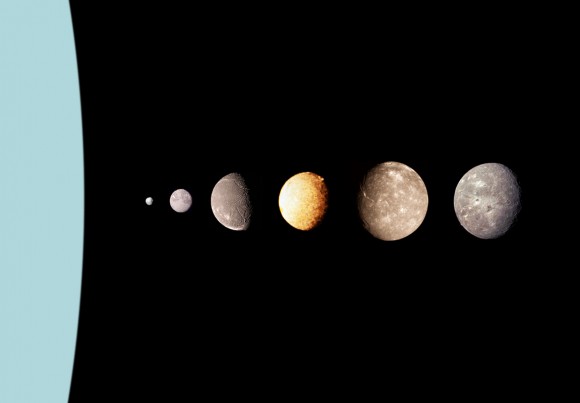
Consistent with the names of the other moons, Kuiper decided to the name the object “Miranda” after the character in Shakespeare’s The Tempest. This continued the tradition set down by John Herschel, who suggested that all the large moons of Uranus – Ariel, Umbriel, Titania and Oberon – be named after characters from either The Tempest or Alexander Pope’s The Rape of the Lock.
Size, Mass and Orbit:
With a mean radius of 235.8 ± 0.7 km and a mass of 6.59 ± 0.75 ×1019 kg, Miranda is 0.03697 Earths times the size of Earth and roughly 0.000011 as massive. Its modest size also makes it one of the smallest object in the Solar System to have achieved hydrostatic equilibrium, with only Saturn’s moon of Mimas being smaller.
Of Uranus’ five larger moons, Miranda is the closest, orbiting at an average distance (semi-major axis) of 129,390 km. It has a very minor eccentricity of 0.0013 and an inclination of 4.232° to Uranus’ equator. This is unusually high for a body so close to its parent planet – roughly ten times that of the other Uranian satellites.
Since there are no mean-motion resonances to explain this, it has been hypothesized that the moons occasionally pass through secondary resonances. At some point, this would have led Miranda into being locked in a temporary 3:1 resonance with Umbriel, and perhaps a 5:3 resonance with Ariel as well. This resonance would have altered the moon’s inclination, and also led to tidal heating in its interior (see below).
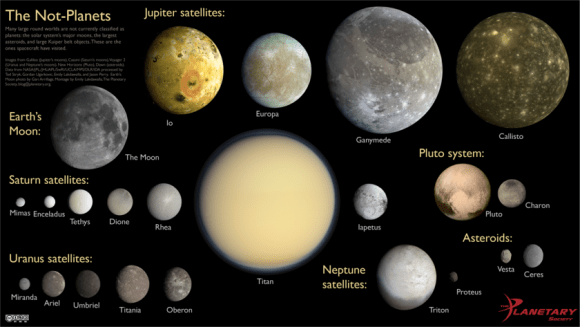
With an average orbital speed of 6.66 km/s, Miranda takes 1.4 days to complete a single orbit of Uranus. Its orbital period (also 34 hours) is synchronous with its rotational period, meaning that it is tidally-locked with Uranus and maintains one face towards it at all times. Given that it orbits around Uranus’ equator, which means its orbit is perpendicular to the Sun’s ecliptic, Uranus goes through an extreme seasonal cycle where the northern and southern hemispheres experience 42 years of lightness and darkness at a time.
Composition and Surface Structure:
Miranda’s mean density (1.2 g/cm3) makes it the least dense of the Uranian moons. It also suggests that Miranda is largely composed of water ice (at least 60%), with the remainder likely consisting of silicate rock and organic compounds in the interior. The surface of Miranda is also the most diverse and extreme of all moons in the Solar System, with features that appear to be jumbled together in a haphazard fashion.
This consists of huge fault canyons as deep as 20 km (12 mi), terraced layers, and the juxtaposition of old and young surfaces seemingly at random. This patchwork of broken terrain indicates that intense geological activity took place in Miranda’s past, which is believed to have been driven by tidal heating during the time when it was in orbital resonance with Umbriel (and perhaps Ariel).
This resonance would have increased orbital eccentricity, and along with varying tidal forces from Uranus, would have caused warming in Miranda’s interior and led to resurfacing. In addition, the incomplete differentiation of the moon, whereby rock and ice were distributed more uniformly, could have led to an upwelling of lighter material in some areas, thus leading to young and older regions existing side by side.
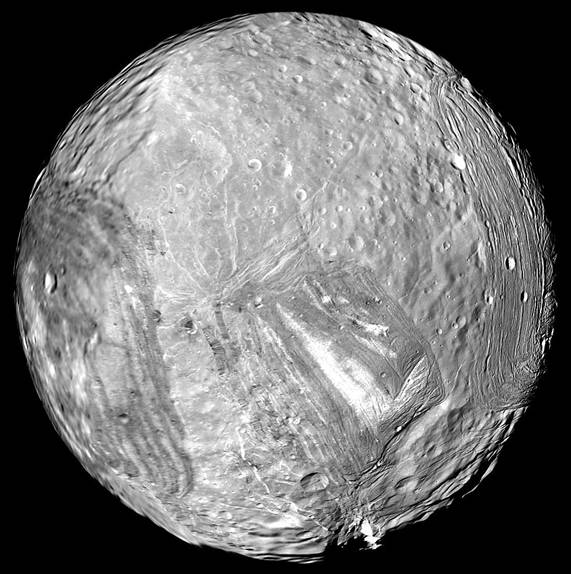
Another theory is that Miranda was shattered by a massive impact, the fragments of which reassembled to produce a fractured core. In this scenario – which some scientists believe could have happened as many as five times – the denser fragments would have sunk deep into the interior, with water ice and volatiles setting on top of them and mirroring their fractured shape.
Overall, scientists recognize five types of geological features on Miranda, which includes craters, coronae (large grooved features), regiones (geological regions), rupes (scarps or canyons) and sulci (parallel grooves).
Miranda’s cratered regions are differentiated between younger, lightly-cratered regions and older, more-heavily cratered ones. The lightly cratered regions include ridges and valleys, which are separated from the more heavily-cratered areas by sharp boundaries of mismatched features. The largest known craters are about 30 km (20 mi) in diameter, with others lying in the range of 5 to 10 km (3 to 6 mi).
Miranda has the largest known cliff in the Solar System, which is known as Verona Rupes (named after the setting of Shakespeare’s Romeo and Juliet). This rupes has a drop-off of over 5 km (3.1 mi) – making it 12 times as deep as the Grand Canyon. Scientists suspect that Miranda’s ridges and canyons represent extensional tilt blocks – a tectonic event where tectonic plates stretch apart, forming patterns of jagged terrain with steep drops.
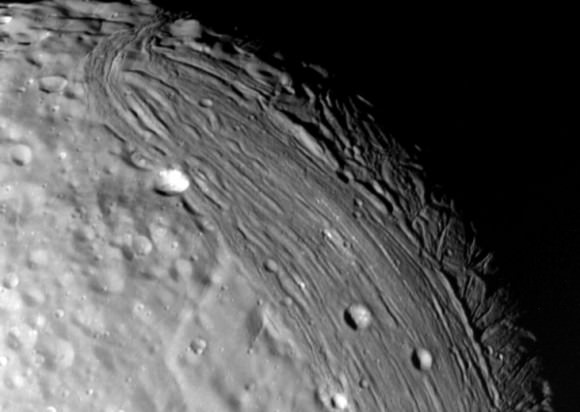
The most well known coronae exist in the southern hemisphere, with three giant ‘racetrack’-like grooved structures that measure at least 200 km (120 mi) wide and up to 20 km (12 mi) deep. These features, named Arden, Elsinore and Inverness – all locations in Shakespeare’s plays – may have formed via extensional processes at the tops of diapirs (aka. upwellings of warm ice).
Other features may be due to cryovolcanic eruptions of icy magma, which would have been driven by tidal flexing and heating in the past. With an albedo of 0.32, Miranda’s surface is nearly as bright as that of Ariel, the brightest of the larger Uranian moons. It’s slightly darker appearance is likely due to the presence of carbonaceous material within its surface ice.
Exploration:
Miranda’s apparent magnitude makes it invisible to many amateur telescopes. As a result, virtually all known information regarding its geology and geography was obtained during the only flyby of the Uranian system, which was made by Voyager 2 in 1986. During the flyby, Miranda’s southern hemisphere pointed towards the Sun (while the northern was shrouded in darkness), so only the southern hemisphere could be studied.
At this time, no future missions have been planned or are under consideration. But given Miranda’s “Frankenstein”-like appearance and the mysteries that still surround its history and geology, any future missions to study Uranus and its system of moons would be well-advised.
We have many interesting articles on Miranda and Uranus’ moons here at Universe Today. Here’s one about about why they call it the “Frankenstein Moon“, and one about Voyager 2‘s historic flyby. And here’s one that answers the question How Many Moons Does Uranus Have?
For more information, check out NASA’s Solar System Exploration page on Miranda.
Sources:
Astronomers See a Massive Black Hole Tear a Star Apart
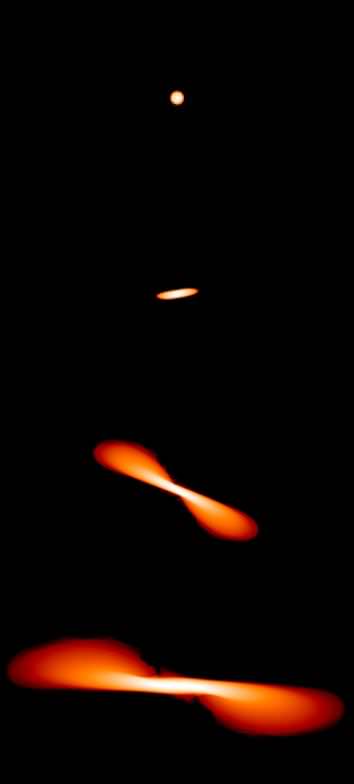
A telescope peers into the blackness of deep space. Suddenly – a brilliant flash of light appears that wasn’t there before. What could it be? A supernova? Two massively dense stars fusing together? Perhaps a gamma ray burst?
Five years ago, researchers using the ROTSE IIIb telescope at McDonald Observatory noticed just such an event. But far from being your run-of-the-mill stellar explosion or neutron star merger, the astronomers believe that this tiny flare was, in fact, evidence of a supermassive black hole at the center of a distant galaxy, tearing a star to shreds.
Astronomers at McDonald had been using the telescope to scan the skies for such nascent flashes for years, as part of the ROTSE Supernova Verification Project (SNVP). And at first blush, the event seen in early 2009, which the researches nicknamed “Dougie,” looked just like many of the other supernovae they had discovered over the course of the project. With a blazing – 22.5-magnitude absolute brightness, the event fit squarely within the class of superluminous supernovae that the researchers were already familiar with.
But as time went on and more data on Dougie rolled in, the astronomers began to change their minds. X-ray observations made by the orbiting Swift satellite and optical spectra taken by McDonald’s Hobby-Eberly Telescope revealed an evolving light curve and chemical makeup that didn’t fit with computer simulations of superluminous supernovae. Likewise, Dougie didn’t appear to be a neutron star merger, which would have reached peak luminosity far more quickly than was observed, or a gamma ray burst, which, even at an angle, would have appeared far brighter in x-ray light.
That left only one option: a so-called “tidal disruption event,” or the carnage and spaghettification that occurs when a star wanders too close to a black hole’s horizon. J. Craig Wheeler, head of the supernova group at The University of Texas at Austin and a member of the team that discovered Dougie, explained that at short distances, a black hole’s gravity exerts a much stronger pull on the side of the star nearest to it than it does on the star’s opposite side. He explained, “These especially large tides can be strong enough that you pull the star out into a noodle.”
The team refined their models of the event and came to a surprising conclusion: having drawn in Dougie’s stellar material a bit faster than it could handle, the black hole was now “choking” on its latest meal. This is due to an astrophysical principle called the Eddington Limit, which states that a black hole of a given size can only handle so much infalling material. After this limit has been reached, any additional intake of matter exerts more outward pressure than the black hole’s gravity can compensate for. This pressure increase has a kind of rebound effect, throwing off material from the black hole’s accretion disk along with heat and light. Such a burst of energy accounts for at least part of Dougie’s brightness, but also indicates that the original dying star – a star not unlike our own Sun – wasn’t going down without a fight.
Combining these observations with the mathematics of the Eddington Limit, the researchers estimated the black hole’s size to be about 1 million solar masses – a rather small black hole, at the center of a rather small galaxy, three billion light years away. Discoveries like these not only allow astronomers to better understand the physics of black holes, but also properties of their often unassuming home galaxies. After all, mused Wheeler, “Who knew this little guy had a black hole?”
To get a simulated glimpse of Dougie for yourself, check out the amazing animation below, courtesy of team member James Guillochon:
The research is published in this month’s issue of The Astrophysical Journal. A pre-print of the paper is available here.
Effects of Einstein’s Elusive Gravitational Waves Observed
Two white dwarfs similar to those in the system SDSS J065133.338+284423.37 spiral together in this illustration from NASA. Credit: D. Berry/NASA GSFC
Locked in a spiraling orbital embrace, the super-dense remains of two dead stars are giving astronomers the evidence needed to confirm one of Einstein’s predictions about the Universe.
A binary system located about 3,000 light-years away, SDSS J065133.338+284423.37 (J0651 for short) contains two white dwarfs orbiting each other rapidly — once every 12.75 minutes. The system was discovered in April 2011, and since then astronomers have had their eyes — and four separate telescopes in locations around the world — on it to see if gravitational effects first predicted by Einstein could be seen.
According to Einstein, space-time is a structure in itself, in which all cosmic objects — planets, stars, galaxies — reside. Every object with mass puts a “dent” in this structure in all dimensions; the more massive an object, the “deeper” the dent. Light energy travels in a straight line, but when it encounters these dents it can dip in and veer off-course, an effect we see from Earth as gravitational lensing.
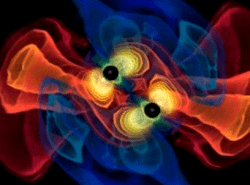 Einstein also predicted that exceptionally massive, rapidly rotating objects — such as a white dwarf binary pair — would create outwardly-expanding ripples in space-time that would ultimately “steal” kinetic energy from the objects themselves. These gravitational waves would be very subtle, yet in theory, observable.
Einstein also predicted that exceptionally massive, rapidly rotating objects — such as a white dwarf binary pair — would create outwardly-expanding ripples in space-time that would ultimately “steal” kinetic energy from the objects themselves. These gravitational waves would be very subtle, yet in theory, observable.
Read: Astronomy Without a Telescope: Gravitational Waves
What researchers led by a team at The University of Texas at Austin have found is optical evidence of gravitational waves slowing down the stars in J0651. Originally observed in 2011 eclipsing each other (as seen from Earth) once every six minutes, the stars now eclipse six seconds sooner. This equates to a predicted orbital period reduction of about 0.25 milliseconds each year.*
“These compact stars are orbiting each other so closely that we have been able to observe the usually negligible influence of gravitational waves using a relatively simple camera on a 75-year-old telescope in just 13 months,” said study lead author J.J. Hermes, a graduate student at The University of Texas at Austin.
Based on these measurements, by April 2013 the stars will be eclipsing each other 20 seconds sooner than first observed. Eventually they will merge together entirely.
Although this isn’t “direct” observation of gravitational waves, it is evidence inferred by their predicted effects… akin to watching a floating lantern in a dark pond at night moving up and down and deducing that there are waves present.
“It’s exciting to confirm predictions Einstein made nearly a century ago by watching two stars bobbing in the wake caused by their sheer mass,” said Hermes.
As of early last year NASA and ESA had a proposed mission called LISA (Laser Interferometer Space Antenna) that would have put a series of 3 detectors into space 5 million km apart, connected by lasers. This arrangement of precision-positioned spacecraft could have detected any passing gravitational waves in the local space-time neighborhood, making direct observation possible. Sadly this mission was canceled due to FY2012 budget cuts for NASA, but ESA is moving ahead with developments for its own gravitational wave mission, called eLISA/NGO — the first “pathfinder” portion of which is slated to launch in 2014.
The study was submitted to Astrophysical Journal Letters on August 24. Read more on the McDonald Observatory news release here.
Inset image: simulation of binary black holes causing gravitational waves – C. Reisswig, L. Rezzolla (AEI); Scientific visualization – M. Koppitz (AEI & Zuse Institute Berlin)
*The difference in the eclipse time is noted as six seconds even though the orbital period decay of the two stars is only .25 milliseconds/year because of a pile-up effect of all the eclipses observed since April 2011. The measurements made by the research team takes into consideration the phase change in the J0651 system, which experiences a piling effect — similar to an out-of-sync watch — that increases relative to time^2 and is therefore a larger and easier number to detect and work with. Once that was measured, the actual orbital period decay could be figured out.

